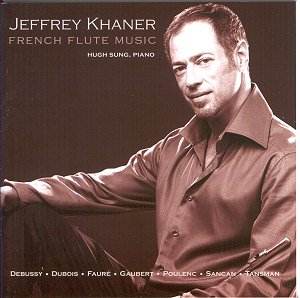When
reviewing Jeffrey Khaner’s disc of American
flute music last year, one reservation I expressed was that
there was, understandably, a certain sameness about the programme.
That is equally true here; all the music tends to speak with the
same ‘accent’ as it were. This is not surprising, and it may be
that I am being unfair, and that the perceived sameness would
prevail in any selection of flute and piano music written
within a fairly tightly defined period; I don’t know. Notice that
I use the word ‘sameness’ deliberately, not ‘monotony’, which
would be misleading. But, to do it justice, I wouldn’t listen
to it all in one ‘go’.
The
programme is cleverly devised to include some staple items of
the flute repertoire – the Fauré, Poulenc and Debussy pieces
– interspersed with some less familiar music, including just the
one piece by a living composer, Pierre Sancan. In fairness, one
should say that the Dubois, Tansman and, in particular, Gaubert
works will be quite familiar to many flautists.
Khaner
is principal flautist of the Philadelphia Orchestra, and before
that held the same position in Cleveland. He is thus a distinguished
player by any standards. What is impressive about him, though,
is his great musicianship and sense of style. His technique is
so secure that one feels that it is being put entirely at the
service of the music rather than the reverse, as can be the case
with some exponents of this instrument, which does lend itself
to fireworks.
The
Avie recording is more than acceptable, though it is interesting
to note that the engineers seem to have very slightly shifted
the balance between flute and piano as compared with the American
disc. However, the recording venue has changed, too, so some difference
in the sound picture is only to be expected. The result is that
Sung is a little further forward, and in places, e.g. the end
of the Fauré, seems to be having to play in a deliberately
restrained way to avoid drowning Khaner.
Nevertheless,
these are convincing and absorbing performances. The Dubois that
starts the collection is a most attractive piece. Its chirpy opening
recalls the finale of the great Prokofiev sonata, and it shows
the influence not only of Les Six, but of their successors such
as Ibert or Françaix. The middle movement is a slow, melancholy
waltz, which demonstrates Khaner’s fine tone, richly expressive
yet pure, with the minimum of that breathiness that can afflict
flute sound in the lower registers. The final Rondo is based on
a simple, good-natured tune, which is subjected to rigorous transformations,
before emerging more or less unscathed. This is an attractive
piece, entertaining though not too demanding on the listener.
The
Gaubert Sonata in A is a more serious-minded work, beautifully
written for the instrument, as you would expect from this composer,
who was one of the outstanding players of his generation, and
later became a famous conductor. The central Lent movement,
is memorable for its wide-ranging melodic lines, as is the main
theme of the finale, with its constant questioning cadences. The
duo give a committed, idiomatic performance of this exquisite
work; they have competition here, principally from Susan Milan
and Ian Brown on Chandos, but Khaner and Sung are in no way inferior
in their shaping and characterising of the music.
The
Fauré Fantaisie is a mere four and a half minutes
long, but, as one flautist commented to me, it can seem like an
eternity. From the listener’s point of view, however, it is sheer
pleasure, from the disconsolately side-stepped cadences of the
Andantino, (a link with the Gaubert there), to the effervescent
Allegro. Khaner, to his credit, makes it sound like no
trouble at all, and the contrasting lyrical theme sings out with
appropriate rapture.
I
confess to being slightly disappointed with the Tansman. I am
generally a great admirer of this Polish-born composer’s attractive
music. It is in five very short movements, giving it, as the booklet
notes (very well written and informative ones) comment, a suite-like
feeling. One could call it ‘bitty’ if one was feeling unkind,
and the level of invention seemed to me less than typical of the
composer at his best. The third movement, a Foxtrot with
oriental inflections, is the most attractive part.
The
Poulenc is easily the best-known of the sonatas on the disc, and
the most recorded, too. I enjoyed this performance, but my preference,
if pressed, is for Emily Beynon’s more sharply characterised version
on Hyperion. Khaner takes a very free approach, with lots of rubato,
which is fine, but can, and does, break up the flow of the music.
And a more serious problem emerges in the finale, Presto giocoso;
in the main theme (track 16, first 8 seconds or so), the tempo
is not maintained strictly, Khaner slowing down slightly but perceptibly
for the tongued semiquavers. This happens at the later reprises
of the tune, and is not to be recommended as an interpretative
detail! On the credit side, Khaner’s command of the very high
register, which much of this movement inhabits, is truly superb.
Pierre
Sancan’s short single-movement work is a delight. Its equivocal
opening reminded me a little of the Lennox Berkeley Sonatina,
and later he makes attractive use of flutter-tonguing, though
he resists the temptation to overdo it. The piano writing contains
many delicious touches (earlier in his life, Sancan was a distinguished
concerto soloist and chamber musician), and the interplay between
the two instruments is complex and symbiotic. I suppose the idiom
could be best described as ‘post-Ravelian’, but Sancan has his
own distinctive voice.
A
wonderfully controlled version of Debussy’s unaccompanied classic
Syrinx – there is no more magical music for summer evening
listening – completes this fine disc. It represents another splendid
achievement for Khaner, Sung and the Avie team. Flautists everywhere
will naturally rush to hear it, but it is full of great delights
for the ‘general’ listener (whatever that might be!)
Gwyn
Parry-Jones
